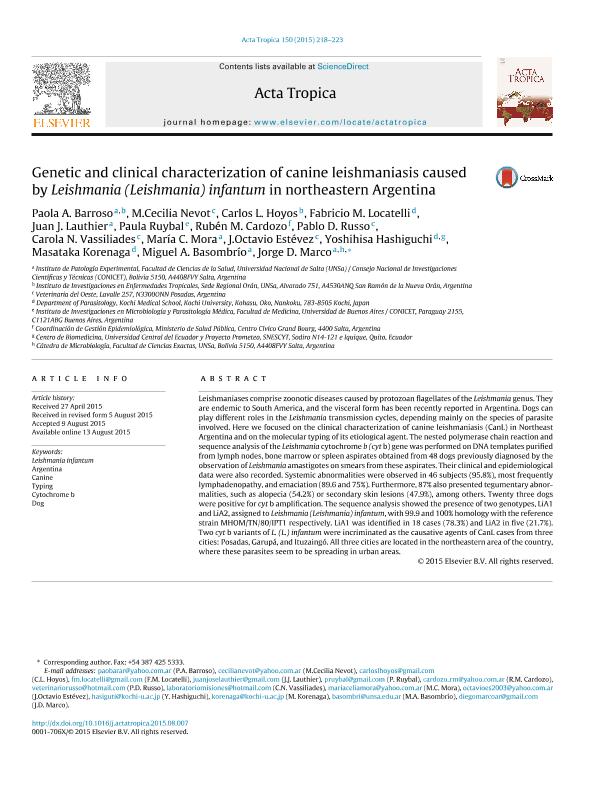Artículo
Genetic and clinical characterization of canine leishmaniasis caused by Leishmania (Leishmania) infantum in northeastern Argentina
Barroso, Paola Andrea ; Nevot, M. Cecilia; Hoyos, Carlos Lorenzo
; Nevot, M. Cecilia; Hoyos, Carlos Lorenzo ; Locatelli, Fabricio M.; Lauthier, Juan José
; Locatelli, Fabricio M.; Lauthier, Juan José ; Ruybal, Paula
; Ruybal, Paula ; Cardozo, Rubén Marino; Russo, Pablo D.; Vassiliades, Carola N.; Mora, Maria Celia
; Cardozo, Rubén Marino; Russo, Pablo D.; Vassiliades, Carola N.; Mora, Maria Celia ; Estévez, J. Octavio; Hashiguchi, Yoshihisa; Korenaga, Masataka; Basombrío, Miguel Ángel Manuel
; Estévez, J. Octavio; Hashiguchi, Yoshihisa; Korenaga, Masataka; Basombrío, Miguel Ángel Manuel ; Marco, Jorge Diego
; Marco, Jorge Diego
 ; Nevot, M. Cecilia; Hoyos, Carlos Lorenzo
; Nevot, M. Cecilia; Hoyos, Carlos Lorenzo ; Locatelli, Fabricio M.; Lauthier, Juan José
; Locatelli, Fabricio M.; Lauthier, Juan José ; Ruybal, Paula
; Ruybal, Paula ; Cardozo, Rubén Marino; Russo, Pablo D.; Vassiliades, Carola N.; Mora, Maria Celia
; Cardozo, Rubén Marino; Russo, Pablo D.; Vassiliades, Carola N.; Mora, Maria Celia ; Estévez, J. Octavio; Hashiguchi, Yoshihisa; Korenaga, Masataka; Basombrío, Miguel Ángel Manuel
; Estévez, J. Octavio; Hashiguchi, Yoshihisa; Korenaga, Masataka; Basombrío, Miguel Ángel Manuel ; Marco, Jorge Diego
; Marco, Jorge Diego
Fecha de publicación:
10/2015
Editorial:
Elsevier Science
Revista:
Acta Tropica
ISSN:
0001-706X
Idioma:
Inglés
Tipo de recurso:
Artículo publicado
Resumen
Leishmaniases comprise zoonotic diseases caused by protozoan flagellates of the Leishmania genus. They are endemic to South America, and the visceral form has been recently reported in Argentina. Dogs can play different roles in the Leishmania transmission cycles, depending mainly on the species of parasite involved. Here we focused on the clinical characterization of canine leishmaniasis (CanL) in Northeast Argentina and on the molecular typing of its etiological agent. The nested polymerase chain reaction and sequence analysis of the Leishmania cytochrome b (cyt b) gene was performed on DNA templates purified from lymph nodes, bone marrow or spleen aspirates obtained from 48 dogs previously diagnosed by the observation of Leishmania amastigotes on smears from these aspirates. Their clinical and epidemiological data were also recorded. Systemic abnormalities were observed in 46 subjects (95.8%), most frequently lymphadenopathy, and emaciation (89.6 and 75%). Furthermore, 87% also presented tegumentary abnormalities, such as alopecia (54.2%) or secondary skin lesions (47.9%), among others. Twenty three dogs were positive for cyt b amplification. The sequence analysis showed the presence of two genotypes, LiA1 and LiA2, assigned to Leishmania (Leishmania) infantum, with 99.9 and 100% homology with the reference strain MHOM/TN/80/IPT1 respectively. LiA1 was identified in 18 cases (78.3%) and LiA2 in five (21.7%). Two cyt b variants of L. (L.) infantum were incriminated as the causative agents of CanL cases from three cities: Posadas, Garupá, and Ituzaingó. All three cities are located in the northeastern area of the country, where these parasites seem to be spreading in urban areas.
Palabras clave:
Argentina
,
Canine
,
Cytochrome B
,
Dog
,
Leishmania Infantum
,
Typing
Archivos asociados
Licencia
Identificadores
Colecciones
Articulos(IMPAM)
Articulos de INSTITUTO DE INVESTIGACIONES EN MICROBIOLOGIA Y PARASITOLOGIA MEDICA
Articulos de INSTITUTO DE INVESTIGACIONES EN MICROBIOLOGIA Y PARASITOLOGIA MEDICA
Citación
Barroso, Paola Andrea; Nevot, M. Cecilia; Hoyos, Carlos Lorenzo; Locatelli, Fabricio M.; Lauthier, Juan José; et al.; Genetic and clinical characterization of canine leishmaniasis caused by Leishmania (Leishmania) infantum in northeastern Argentina; Elsevier Science; Acta Tropica; 150; 10-2015; 218-223
Compartir
Altmétricas



